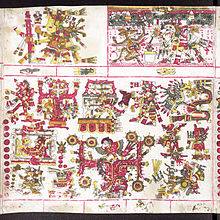Thirteen Heavens
The Nahua people such as the Aztecs, Chichimecs and the Toltecs believed that the heavens were constructed and separated into 13 levels. Each level had from one to many Lords (gods) living in and ruling them.
Aztec mythology
| Aztec civilization |
|---|
 |
| Aztec society |
| Aztec history |


In Aztec mythology, the Thirteen Heavens were formed out of Cipactli's head when the gods made creation out of its body, whereas Tlaltipac, the earth, was made from its center and the nine levels of the underworld (Mictlan) from its tail.[1]
The most important of these heavens was Omeyocan (Place of Two), where Ometeotl - the dual Lord, creator of the Dual-Genesis who, as male, takes the name Ometecuhtli (Two Lord), and as female is named Omecihuatl (Two Lady) - resided.


| Thirteen Heavens | |||
| Name | Dwellers | ||
|---|---|---|---|
| 1 | "Sky where the moon moves" |
Here the moon and the clouds are in motion. | |
| 2 | "Where the stars move" |
Here the stars are in motion. | |
| 3 | "Where the Sun moves" |
Western abode of the yellow god, to where the sun travels before submerging into the Mictlan underworld. | |
| 4 | "The sky of the Big Star" |
The way of Venus. | |
| 5 | "Sky that is sinking or being drilled" |
Here the comets (called citlallinpopoca or also citlalmina or xihuitl, depending on their shape) are in motion. | |
| 6 | "Dark green space" |
Place from where the night comes and spreads. | |
| 7 | "Region of blue" |
Here the sun shows its face at dawn. Sky that is seeing during the day. | |
| 8 | "Where the obsidian knives are creaking" |
Place of storms. Heavenly abode of the god of death from where the darkness comes. | |
| 9 | "Region of white" |
Abode of the white god and stellar spirits. | |
| 10 | "Region of yellow" |
Eastern abode of the Yellow God where he comes from and goes to the west. | |
| 11 | "Region of red" |
Abode of the red god. Red sky with rays of light to express that the first creation of the world was the earthly fire. | |
| 12 | "Sky that is the place of the gods" |
Abode of the gods. Ruled by the Four Creator Lords or Tezcatlipocas. Eminently divine place where the deities remain and project themselves to be in other places. Where the gods take on faces, and where they put on masks to become others while still being themselves. Where they are born, reborn and feed in their quality of eternal and mutating beings.[1] | |
| 13 | "Place of Two", "Place of Duality" |
Residence or mansion of the creator couple; source of the gods and the creation of the universe, where the generating principle of all that exists is conceived. | |
Notes
- ^ a b Adela Fernández (1 January 1992). Dioses prehispánicos de México: mitos y deidades del panteón náhuatl. Panorama Editorial. pp. 30, 33, 34. ISBN 978-968-38-0306-1.
References
Cecilio Agustín Robelo (1905). Diccionario de Mitología Nahua. México: Biblioteca Porrúa. Imprenta del Museo Nacional de Arqueología, Historia y Etnología. p. 851. ISBN 978-9684327955.
See also

